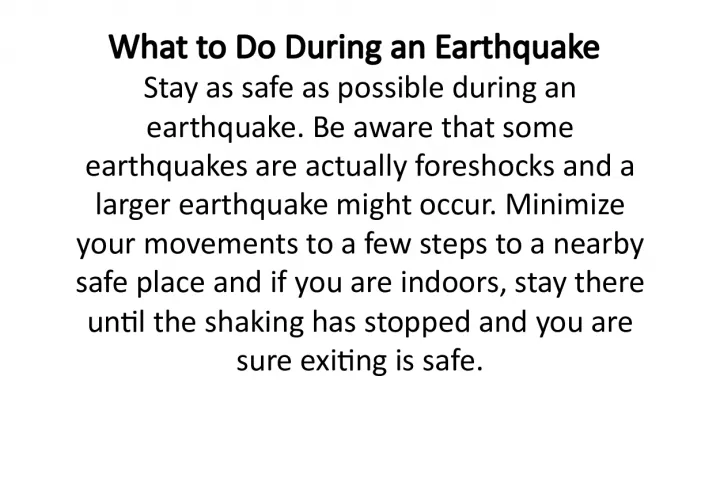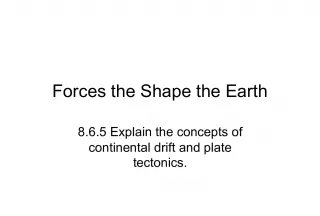What to Do During an Earthquake


This article provides helpful tips on how to stay as safe as possible during an earthquake. It's important to be aware that some earthquakes may be foreshocks and a larger earthquake may occur,
- Uploaded on | 0 Views
-
 arpitha
arpitha
About What to Do During an Earthquake
PowerPoint presentation about 'What to Do During an Earthquake'. This presentation describes the topic on This article provides helpful tips on how to stay as safe as possible during an earthquake. It's important to be aware that some earthquakes may be foreshocks and a larger earthquake may occur,. The key topics included in this slideshow are . Download this presentation absolutely free.
Presentation Transcript
Slide1What to Do During an EarthquakeStay as safe as possible during an earthquake. Be aware that some earthquakes are actually foreshocks and a larger earthquake might occur. Minimize your movements to a few steps to a nearby safe place and if you are indoors, stay there until the shaking has stopped and you are sure exiting is safe.
Slide2If indoorsDROP to the ground; take COVER by getting under a sturdy table or other piece of furniture; and HOLD ON until the shaking stops. If there isn’t a table or desk near you, cover your face and head with your arms and crouch in an inside corner of the building. Stay away from glass, windows, outside doors and walls, and anything that could fall, such as lighting fixtures or furniture. Use a doorway for shelter only if it is in close proximity to you and if you know it is a strongly supported, loadbearing doorway. Stay inside until the shaking stops and it is safe to go outside. Research has shown that most injuries occur when people inside buildings attempt to move to a different location inside the building or try to leave. Be aware that the electricity may go out or the sprinkler systems or fire alarms may turn on. DO NOT use the elevators.
Slide3 If outdoorsStay there. Move away from buildings, streetlights, and utility wires. Once in the open, stay there until the shaking stops. The greatest danger exists directly outside buildings, at exits and alongside exterior walls. Many of the 120 fatalities from the 1933 Long Beach earthquake occurred when people ran outside of buildings only to be killed by falling debris from collapsing walls. Ground movement during an earthquake is seldom the direct cause of death or injury. Most earthquake-related casualties result from collapsing walls, flying glass, and falling objects.
Slide4 If in a moving vehicleStop as quickly as safety permits and stay in the vehicle. Avoid stopping near or under buildings, trees, overpasses, and utility wires. Proceed cautiously once the earthquake has stopped. Avoid roads, bridges, or ramps that might have been damaged by the earthquake .
Slide5 If trapped under debrisDo not light a match. Do not move about or kick up dust. Cover your mouth with a handkerchief or clothing. Tap on a pipe or wall so rescuers can locate you. Use a whistle if one is available. Shout only as a last resort. Shouting can cause you to inhale dangerous amounts of dust .

